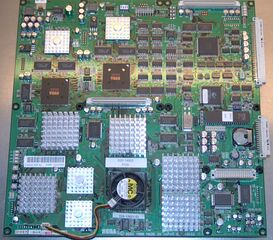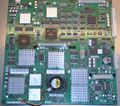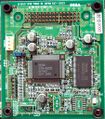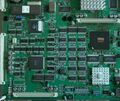Difference between revisions of "Sega Hikaru"
From Sega Retro
Doc eggfan (talk | contribs) |
|||
| Line 14: | Line 14: | ||
}} | }} | ||
}} | }} | ||
| − | The '''Sega Hikaru''' is an evolution of the NAOMI hardware with superior graphics capabilities, the Hikaru was used for a handful of deluxe dedicated-cabinet games, beginning with 1999's ''[[Brave Fire Fighters]]''. Since it was comparatively expensive to produce, Sega soon abandoned the Hikaru in favor of continued NAOMI and NAOMI 2 development. | + | The '''Sega Hikaru''' is an evolution of the [[Sega NAOMI|NAOMI]] hardware with superior graphics capabilities, the Hikaru was used for a handful of deluxe dedicated-cabinet games, beginning with 1999's ''[[Brave Fire Fighters]]'', in which the flame and water effects were largely a showpiece for the hardware. The Hikaru hardware was the first arcade platform capable of effective [http://www.giantbomb.com/phong-shading/3015-7940/ Phong shading]. |
| + | |||
| + | Since it was comparatively expensive to produce, Sega soon abandoned the Hikaru in favor of continued NAOMI and NAOMI 2 development. | ||
| + | |||
| + | ==Development== | ||
| + | According to Sega in 1999: "''Brave Firefighters utilizes a slightly modified Naomi Hardware system called Hikaru. Hikaru incorporates a custom Sega graphics chip and possesses larger memory capacity then standard Naomi systems. "These modifications were necessary because in Brave Firefighters, our engineers were faced with the daunting challenge of creating 3d images of flames and sprayed water," stated Sega's Vice President of Sales and Marketing, Barbara Joyiens. "If you stop and think about it, both have an almost infinite number of shapes, sizes, colors, levels of opaqueness, shadings and shadows. And, when you combine the two by simulating the spraying of water on a flame, you create an entirely different set of challenges for our game designers and engineers to overcome; challenges that would be extremely difficult, if not impossible to overcome utilizing existing 3D computers. Hikaru has the horsepower to handle these demanding graphic challenges with clarity, depth and precision.''"{{ref|http://www.goodcowfilms.com/farm/games/news-archive/Sega%20Confirms%20Hikaru%20DOES%20Exist....htm}} | ||
==Specifications== | ==Specifications== | ||
| − | * CPU: | + | * Main CPU: 2× [[wikipedia:SuperH|Hitachi SH-4]] @ 200 MHz |
| − | * | + | ** Features: 2× [[wikipedia:128-bit|128-bit]] [[wikipedia:SIMD|SIMD]] @ 200 MHz, 2× [[wikipedia:Floating-point unit|floating-point unit]], graphic functions |
| − | * | + | ** Performance: 720 [[wikipedia:Instructions per second|MIPS]] and 2.8 [[wikipedia:FLOPS|GFLOPS]] |
| − | * Main | + | * [[wikipedia:Computer network|Network]] CPU: [[Motorola 68000]] |
| − | * | + | * [[wikipedia:Sound chip|Sound engine]]: 2× [[wikipedia:Yamaha Super Intelligent Sound Processor|Yamaha AICA Super Intelligent Sound Processor]] @ 67 MHz |
| − | * Sound | + | ** Internal CPU: 2× 32-bit [[wikipedia:ARM7|ARM7]] RISC CPU @ 45 MHz |
| − | * | + | ** CPU performance: 34 MIPS (2× 17 MIPS) |
| − | * | + | ** [[Pulse-code modulation|PCM/ADPCM]]: 16-bit [[wikipedia:Audio bit depth|depth]], 48 kHz [[wikipedia:Sampling rate|sampling rate]] ([[wikipedia:DVD-Audio|DVD quality]]), 128 channels |
| − | * | + | ** Other features: DSP, sound [[wikipedia:Synthesizer|synthesizer]] |
| − | * | + | * Main [http://gaming.wikia.com/wiki/Transform,_clipping,_and_lighting T&L] GPU [http://gaming.wikia.com/wiki/Graphics_processing_unit Graphics Engine]: Sega Custom 3D |
| − | * | + | ** [[wikipedia:Computer graphics lighting|Lighting]]: Horizontal, spot, 1024 lights per scene, 4 lights per polygon, 8 window surfaces |
| − | * | + | ** Shading: [http://www.giantbomb.com/phong-shading/3015-7940/ Phong shading], shadow |
| − | * | + | ** Rendering: Fog, [[wikipedia:Depth perception|depth cueing]] |
| − | * Extensions: communication, 4 channel audio, PCI, MIDI, RS-232C | + | ** Other effects: [[wikipedia:Stencil buffer|Stencil]], [http://www.giantbomb.com/motion-blur/3015-248/ motion blur], [http://www.giantbomb.com/particle-system/3015-4608/ particle effects], fire effects, [[wikipedia:Fluid simulation|water effects]] |
| − | * Connection: JAMMA Video compliant | + | ** Other capabilities: 2 [[wikipedia:Bitmap|bitmap]] layers, calendar |
| + | * Rasterizer [http://gaming.wikia.com/wiki/Graphics_processing_unit GPU]: 2× [[NEC]]-[[wikipedia:Imagination Technologies|VideoLogic]] [[wikipedia:PowerVR#Series 2|PowerVR 2]] (PVR2DC/CLX2) @ 100 MHz | ||
| + | ** [[wikipedia:Texture mapping|Texture mapping]]: [[wikipedia:Bump mapping|Bump mapping]], [[wikipedia:Mipmap|mipmapping]], [[wikipedia:Environment mapping|environment mapping]], [[wikipedia:Texture compression|texture compression]], [[wikipedia:Multitexturing|multi-texturing]], [[wikipedia:Texture mapping#perspective correctiveness|perspective correction]] | ||
| + | ** [[wikipedia:Texture filtering|Filtering]]: [[wikipedia:Nearest-neighbor interpolation|Point filtering]], [[wikipedia:Bilinear filtering|bilinear filtering]], [[wikipedia:Trilinear filtering|trilinear filtering]], [[wikipedia:Anisotropic filtering|anisotropic filtering]] | ||
| + | ** [[wikipedia:Spatial anti-aliasing|Anti-aliasing]]: [[wikipedia:Supersampling|Super-sampling anti-aliasing]] (SSAA), [[wikipedia:FSAA|full-scene anti-aliasing]] (FSAA) | ||
| + | ** [[wikipedia:Alpha blending|Alpha blending]]: 256 levels of transparency, multi-pass blending, translucency sorting | ||
| + | ** [[wikipedia:Shading|Shading]]: Perspective-correct ARGB [http://www.giantbomb.com/gouraud-shading/3015-4864/ Gouraud shading], [[wikipedia:Shadow mapping|shadows]] | ||
| + | ** [[wikipedia:3D rendering|Rendering]]: [[wikipedia:Render output unit|ROP]] (render output unit), [[wikipedia:tiled rendering|tiled rendering]], 32-bit floating-point [[wikipedia:Z-buffering|Z-buffering]], 32-bit floating-point [[wikipedia:Hidden surface determination|hidden surface removal]], 256 [[wikipedia:Distance fog|fog effects]], per-pixel table fog, [[wikipedia:Per-pixel lighting|per-pixel lighting]] | ||
| + | ** Other capabilities: [[wikipedia:Polygon mesh|Quad polygons]], [[wikipedia:Triangle mesh|triangle polygons]], GMV (general modifier volumes) | ||
| + | * [[wikipedia:Operating system|Operating system]]: Custom [[Windows CE]], with [[DirectX|DirectX 6.0]], [[wikipedia:Direct3D|Direct3D]] and [[OpenGL]] support | ||
| + | * [[wikipedia:Random-access memory|RAM]]: 100 MB | ||
| + | ** Main RAM: 64 MB | ||
| + | ** [[wikipedia:VRAM|VRAM]]: 28 MB | ||
| + | ** Sound [[wikipedia:Synchronous dynamic random-access memory|SDRAM]]: 8 MB | ||
| + | ** Network [[wikipedia:Static random-access memory|SRAM]]: 32 KB | ||
| + | * Storage media: [[Read-only memory|ROM]] Board, up 352 MB | ||
| + | * [[List of color palettes|Color depth]]: [[wikipedia:32-bit color|32-bit]] [[wikipedia:RGBA color space|ARGB]], 16,777,216 colors ([[wikipedia:24-bit color|24-bit color]]) with 8-bit (256 levels) [[wikipedia:Alpha compositing|alpha blending]], [[wikipedia:YUV|YUV]] and [[List of RGB palettes|RGB color space]], [[wikipedia:Chroma key|color key]] overlay | ||
| + | * [[Display resolution]]: 31 kHz [[wikipedia:Horizontal scan rate|horizontal sync]], 60 Hz [[wikipedia:Refresh rate|refresh rate]], [[Dreamcast VGA Adapter|VGA]], [[wikipedia:Progressive scan|progressive scan]] | ||
| + | ** Single monitor: 496×384 to 800×608 pixels | ||
| + | ** [[wikipedia:Multi-monitor|Dual monitor]]: 992×768 to 1600×608 pixels | ||
| + | * [[Three-dimensional|Polygon]] performance: | ||
| + | ** With Phong shading, 4 lights per polygon, 1024 lights per scene, shadows, trilinear filtering, motion blur and all other effects: 4 million textured polygons/sec (2 million per rasterizer GPU) | ||
| + | ** With lighting, shadows and trilinear filtering: 14 million textured polygons/sec (7 million per rasterizer GPU) | ||
| + | ** With lighting: 20 million polygons/sec (10 million per CPU & rasterizer GPU) | ||
| + | * [[Three-dimensional|Fillrate]]: | ||
| + | ** Rendering: 1 billion pixels/sec (with transparent polygons) to over 6.4 billion pixels/sec (with opaque polygons) | ||
| + | ** Textures: 200 million [[wikipedia:Texel (graphics)|texels]]/sec | ||
| + | * Extensions: communication, [http://www.giantbomb.com/surround-sound/3015-2571/ 4-channel surround audio], PCI, [[wikipedia:MIDI|MIDI]], RS-232C | ||
| + | * Connection: [[JAMMA]] Video compliant | ||
==Hardware Images== | ==Hardware Images== | ||
Revision as of 06:49, 7 June 2015

| |||||
| Sega Hikaru | |||||
|---|---|---|---|---|---|
| Manufacturer: Sega | |||||
|
The Sega Hikaru is an evolution of the NAOMI hardware with superior graphics capabilities, the Hikaru was used for a handful of deluxe dedicated-cabinet games, beginning with 1999's Brave Fire Fighters, in which the flame and water effects were largely a showpiece for the hardware. The Hikaru hardware was the first arcade platform capable of effective Phong shading.
Since it was comparatively expensive to produce, Sega soon abandoned the Hikaru in favor of continued NAOMI and NAOMI 2 development.
Development
According to Sega in 1999: "Brave Firefighters utilizes a slightly modified Naomi Hardware system called Hikaru. Hikaru incorporates a custom Sega graphics chip and possesses larger memory capacity then standard Naomi systems. "These modifications were necessary because in Brave Firefighters, our engineers were faced with the daunting challenge of creating 3d images of flames and sprayed water," stated Sega's Vice President of Sales and Marketing, Barbara Joyiens. "If you stop and think about it, both have an almost infinite number of shapes, sizes, colors, levels of opaqueness, shadings and shadows. And, when you combine the two by simulating the spraying of water on a flame, you create an entirely different set of challenges for our game designers and engineers to overcome; challenges that would be extremely difficult, if not impossible to overcome utilizing existing 3D computers. Hikaru has the horsepower to handle these demanding graphic challenges with clarity, depth and precision."[1]
Specifications
- Main CPU: 2× Hitachi SH-4 @ 200 MHz
- Features: 2× 128-bit SIMD @ 200 MHz, 2× floating-point unit, graphic functions
- Performance: 720 MIPS and 2.8 GFLOPS
- Network CPU: Motorola 68000
- Sound engine: 2× Yamaha AICA Super Intelligent Sound Processor @ 67 MHz
- Internal CPU: 2× 32-bit ARM7 RISC CPU @ 45 MHz
- CPU performance: 34 MIPS (2× 17 MIPS)
- PCM/ADPCM: 16-bit depth, 48 kHz sampling rate (DVD quality), 128 channels
- Other features: DSP, sound synthesizer
- Main T&L GPU Graphics Engine: Sega Custom 3D
- Lighting: Horizontal, spot, 1024 lights per scene, 4 lights per polygon, 8 window surfaces
- Shading: Phong shading, shadow
- Rendering: Fog, depth cueing
- Other effects: Stencil, motion blur, particle effects, fire effects, water effects
- Other capabilities: 2 bitmap layers, calendar
- Rasterizer GPU: 2× NEC-VideoLogic PowerVR 2 (PVR2DC/CLX2) @ 100 MHz
- Texture mapping: Bump mapping, mipmapping, environment mapping, texture compression, multi-texturing, perspective correction
- Filtering: Point filtering, bilinear filtering, trilinear filtering, anisotropic filtering
- Anti-aliasing: Super-sampling anti-aliasing (SSAA), full-scene anti-aliasing (FSAA)
- Alpha blending: 256 levels of transparency, multi-pass blending, translucency sorting
- Shading: Perspective-correct ARGB Gouraud shading, shadows
- Rendering: ROP (render output unit), tiled rendering, 32-bit floating-point Z-buffering, 32-bit floating-point hidden surface removal, 256 fog effects, per-pixel table fog, per-pixel lighting
- Other capabilities: Quad polygons, triangle polygons, GMV (general modifier volumes)
- Operating system: Custom Windows CE, with DirectX 6.0, Direct3D and OpenGL support
- RAM: 100 MB
- Storage media: ROM Board, up 352 MB
- Color depth: 32-bit ARGB, 16,777,216 colors (24-bit color) with 8-bit (256 levels) alpha blending, YUV and RGB color space, color key overlay
- Display resolution: 31 kHz horizontal sync, 60 Hz refresh rate, VGA, progressive scan
- Single monitor: 496×384 to 800×608 pixels
- Dual monitor: 992×768 to 1600×608 pixels
- Polygon performance:
- With Phong shading, 4 lights per polygon, 1024 lights per scene, shadows, trilinear filtering, motion blur and all other effects: 4 million textured polygons/sec (2 million per rasterizer GPU)
- With lighting, shadows and trilinear filtering: 14 million textured polygons/sec (7 million per rasterizer GPU)
- With lighting: 20 million polygons/sec (10 million per CPU & rasterizer GPU)
- Fillrate:
- Rendering: 1 billion pixels/sec (with transparent polygons) to over 6.4 billion pixels/sec (with opaque polygons)
- Textures: 200 million texels/sec
- Extensions: communication, 4-channel surround audio, PCI, MIDI, RS-232C
- Connection: JAMMA Video compliant
Hardware Images
List of Games
- Air Trix (2001)
- Brave FireFighters (1999)
- Cyber Troopers Virtual-On Force (2001)
- Cyber Troopers Virtual-On Force Ver.7.7 (2002)
- NASCAR Arcade (2000)
- Planet Harriers (2001)
- Star Wars Racer Arcade (2000)
| Sega arcade boards |
|---|
| Originating in arcades |
|
77
78
79
80
81
82
83
84
85
86
87
88
89
90
91
92
93
94
95
96
97
98
99
|
| Console-based hardware |
|
84
85
86
87
88
89
90
91
92
93
94
95
96
97
98
99
00
01
02
03
04
05
06
07
08
09
10
11
12
13
14
|
| PC-based hardware |
|
05
06
07
08
09
10
11
12
13
14
15
16
17
18
19
20
21
22
23
|












